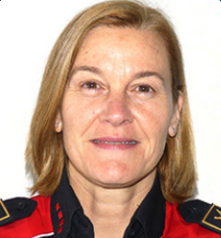

Montserrat Estruch: Coordination between the Mossos d'Esquadra and the Guardia Urbana boosts police effectiveness

Collaboration between the Mossos d’Esquadra (Catalan Police Force) and the Barcelona Guardia Urbana is driving significant progress in public safety. In the following interview, Commissioner Montserrat Estruch López, head of the Mossos d’Esquadra’s Barcelona Metropolitan Police Region (RPMB), outlines how this cooperation is improving outcomes for the city. Crime rates have improved, with a notable drop in property-related offences and, as a result, in incidents involving repeat offenders.
What improvements in public safety are being achieved through the coordination between the Mossos d’Esquadra and the Barcelona Police Force?
The coordination between the two forces is delivering a range of improvements that directly benefit the people of Barcelona, particularly in terms of police efficiency. By aligning both forces around shared intelligence and public perception, we can ensure greater police presence in the areas that need it most, ultimately increasing residents’ sense of safety.
There are tangible results: crime rates in Barcelona have improved significantly, property crime has declined sharply, and offences associated with repeat offending have also fallen. The Mossos d’Esquadra have expanded their street presence, in coordination with the city police, at a time when we’ve seen an uptick in incidents involving knives, narcotics, scooters being used in criminal activity, and arrests made under court orders, among other developments. This increased operational activity places added pressure on criminal networks, making Barcelona a more difficult city in which to commit offences. We can now say with confidence that the overall crime trend is shifting in a positive direction.
Key developments such as the joint command room, integrated coordination at major public events, targeted investigations into drug use and trafficking, and the involvement of the Guardia Urbana in the Regional Accident Investigation Unit are all strengthening the flow of intelligence and adding depth to ongoing investigations. The recent opening of the new Custody Area at the Ciutat Vella police station has also had an impact, reducing travel times for Mossos patrol units who have made arrests, allowing officers to return to the streets more quickly and spend more time on patrol.
What additional resources and systems are required for this joint approach?
This joint approach between the two police services is fundamentally rooted in coordination and respect for each force’s area of responsibility. In this regard, the Mossos d’Esquadra fully support the agreements signed by the Department of the Interior of the Generalitat with Barcelona City Council, which aim to strengthen cooperation and joint working across different levels of government.
A clear example of this collaboration is the integration of the Barcelona city police into the Regional Accident Investigation Unit, demonstrating how the two forces are now sharing not only objectives, but operational spaces.
How are you working to improve the public’s perception of safety?
Our efforts are now focused on the new Pla Confiança (Trust Plan), which was presented at the most recent meeting of Barcelona’s Local Security Board. Despite a slight decrease in overall police activity, the public’s perception of safety in Barcelona continues to improve. That’s why we’re implementing this new plan, structured around several strategic pillars, and the Guardia Urbana will be joining this approach soon. Internally, more than 3,000 Mossos officers working across the city will receive training to help position them as recognised points of reference on safety within their communities. We also plan to strengthen our engagement with local neighbourhood associations and community organisations. This includes providing clear feedback on specific actions taken in response to concerns raised by residents, ensuring our work remains visible and accountable.
Another focus area is our corporate communications, through partnerships with the media, the involvement of official spokespersons, and a proactive presence on social media. The goal is to explain our work clearly and directly to the public.
In short, we at the Mossos d’Esquadra want to be present and visible on the streets of Barcelona. We aim to be approachable, to listen to residents, and to communicate clearly, so that people understand what we do, can tell us what they need from their police service, and feel reassured that Barcelona is a safe city.
What are the goals of the appointment system you’ve introduced?
One topic that has generated some discussion, and even confusion, is the appointment system. It’s a mechanism we’ve introduced to streamline our service to the public and reduce waiting times at police stations. Importantly, it is not mandatory. For example, in Barcelona, people who schedule an appointment typically wait just 10 minutes. Those who come without an appointment may face a wait of around 30 minutes.
It’s important to bear in mind that anyone coming to a police station is likely doing so because they’ve already experienced a stressful or difficult situation. If we can reduce waiting times, provide appropriate guidance, and deliver a professional, empathetic service, we can improve that person’s perception of safety and trust in law enforcement. And that is precisely one of our main goals.




